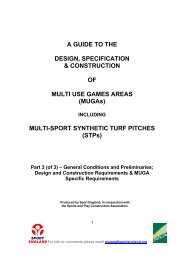View - North East Lincolnshire Council
View - North East Lincolnshire Council
View - North East Lincolnshire Council
You also want an ePaper? Increase the reach of your titles
YUMPU automatically turns print PDFs into web optimized ePapers that Google loves.
BOC Immingham Dissolved Acetylene Project Environmental Statement: Vol. 2 Main Text<br />
Assessment Methodology<br />
14.10 It terms of the assessment of archaeological aspects, the following has tasks have been<br />
undertaken:<br />
� review of readily available historic environment and other designated heritage assets data;<br />
� review of historic maps;<br />
� geophysical survey of development site and review of the findings; and<br />
� consultation with NELC’s Archaeologist (see Table 14.1).<br />
14.11 In terms of the assessment of historic landscape issues, the following tasks have been<br />
undertaken:<br />
� review of readily available historic environment data and secondary sources;<br />
� review of historic maps; and<br />
� site visit (April 2011).<br />
Assessment Criteria<br />
14.12 The assessment criteria and scoring mechanism for assessing the significance of effect are based<br />
on the concept that the environmental effect of the proposals, in relation to an individual asset, is<br />
determined through identifying the asset’s value and then assessing the impact that the proposal<br />
would have on the significance of that asset (i.e. the attributes that provide it with its value). This is<br />
a well established approach of combining value and impact to determine effect and it provides<br />
clear differentiation between significant and insignificant environmental effects. It also reflects<br />
policy in PPS 5, which identifies that different scales of impact (i.e. Substantial Harm and Less<br />
than Substantial Harm) on assets of differing value have a different weighting in national policy<br />
terms.<br />
14.12.1 Table 14.2 sets out the criteria and definitions for determining the value of an asset.<br />
Table 14.2 Definitions of the Value of an Asset<br />
Value Description Example<br />
High<br />
Medium<br />
Low<br />
Nationally or internationally<br />
important heritage assets<br />
generally recognised through<br />
designation as being of<br />
exceptional interest and value.<br />
Heritage assets recognised as<br />
being of special interest,<br />
generally designated.<br />
Assets that are of interest at a<br />
local level primarily for the<br />
contribution to the local historic<br />
environment.<br />
World Heritage Sites, Grade I and II* Listed<br />
Buildings, Grade I and II* Registered Parks<br />
and Gardens, Scheduled Monuments,<br />
Protected Wreck Sites, Registered Historic<br />
Battlefields, Conservation Areas with notable<br />
concentrations of heritage assets and<br />
undesignated assets of national or<br />
international importance.<br />
Grade II Listed Buildings, Grade II<br />
Registered Parks and Gardens,<br />
Conservation Areas and undesignated<br />
assets of regional or national importance.<br />
Undesignated heritage assets such as locally<br />
listed buildings, undesignated archaeological<br />
sites, undesignated historic parks and<br />
gardens etc. Can also include degraded<br />
designated assets that no longer warrant<br />
designation.<br />
5100935.404 Environmental Statement August 2011 253




